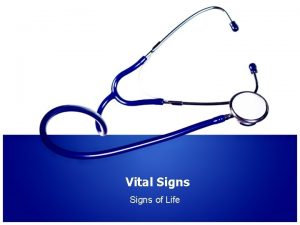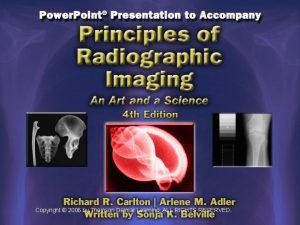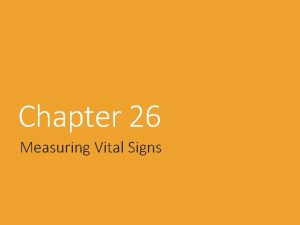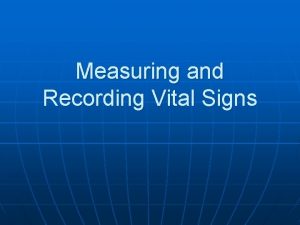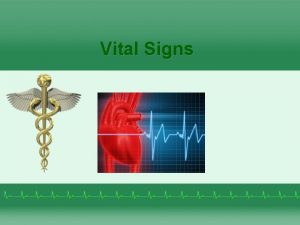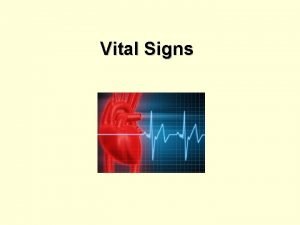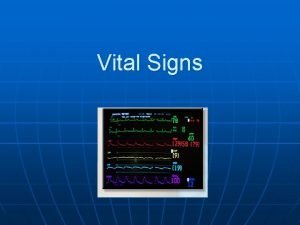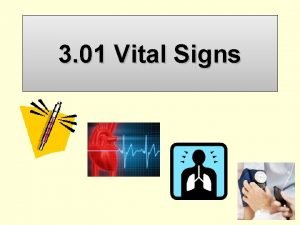Vital Signs 2009 Delmar Cengage Learning 14 1
























- Slides: 24

Vital Signs © 2009 Delmar, Cengage Learning

14: 1 Measuring and Recording Vital Signs (VS) • Vital Signs are defined as various determinations that provide basic information about the basic conditions of the patient • The 4 main vital signs (VS) – – Temperature (T) Pulse (P) Respiration (R) Blood pressure (BP) © 2009 Delmar, Cengage Learning

Other Assessments on Patients • Pain—patients asked to rate on scale of 1 to 10 (1 is minimal and 10 is severe) • Color of skin • Size of pupils and reaction to light • Level of consciousness • Response to stimuli © 2009 Delmar, Cengage Learning

VS Readings • Accuracy is essential • Report abnormality or change • If unable to get reading, ask another person to check • As a health care worker, it is your responsibility to measure and record the VS of your patients © 2009 Delmar, Cengage Learning

14: 2 Measuring and Recording Temperature • Measures balance between heat lost and heat produced in the body • Heat produced by metabolism of food and by muscle and gland activity • Homeostasis: constant state of balance in the body • Conversion between Fahrenheit and Celsius temperature © 2009 Delmar, Cengage Learning

Variations in Body Temperature • Normal range 97 - 100 degrees Fahrenheit • Causes of variations –individual differences, time of day, body sites • Temperature measurements—oral, rectal (often used on infants/children), axillary (arm pit) or groin, aural (ear), and temporal (forehead-is measuring the temp in the temporal artery) © 2009 Delmar, Cengage Learning

Causes of Increased Body Temperature • • • Illness Infection Exercise Excitement High temperatures in the environment © 2009 Delmar, Cengage Learning

Causes of Decreased Body Temperature • • • Starvation or fasting Sleep Decreased muscle activity Mouth breathing Exposure to cold temperatures in the environment • Certain diseases © 2009 Delmar, Cengage Learning

Thermometers • Clinical thermometers – are used to record temperatures – Glass – consists of a slender glass tube containing mercury or alcohol with red dye, which expands when exposed to heat – Electronic – registers the temp on a viewer in a few seconds – Tympanic – records aural temp in the ear – Temporal – measures the temp in the temporal artery of the forehead – Plastic or paper - contain special chemical dots/strips (continues) that change color when exposed to specific temps © 2009 Delmar, Cengage Learning

Thermometers (continued) • Reading thermometers and recording results: * Electronic & tympanic thermometers are easily read because of digital displays * Mercury thermometers should be held at eye level & rotated slowly to find the mercury Examples of how to record a temperature: 98. 6 is an oral reading 99. 6 (R) is a rectal reading 97. 9 (Ax) is an axillary reading 98. 6 (A) is an aural reading © 2009 Delmar, Cengage Learning

Cleaning Thermometers • Must be cleaned after each use • The procedure will vary with different agencies and thermometers • Glass thermometers are cleaned with water and soaked in a disinfectant solution (70% alcohol) for a minimum of 30 minutes before using again • Electronic/digital thermometers use a probe or sheath that is discarded after each use © 2009 Delmar, Cengage Learning

14: 3 Measuring and Recording Pulse • Pressure of the blood pushing against the wall of an artery as the heart beats and rests • Major arterial or pulse sites • Pulse rate • Pulse rhythm • Pulse volume (continues) © 2009 Delmar, Cengage Learning

Measuring and Recording Pulse (continued) • Factors that change pulse rate • Basic principles for taking radial pulse • Recording information © 2009 Delmar, Cengage Learning

14: 4 Measuring and Recording Respirations • Measures the breathing of a patient • Process of taking in oxygen and expelling carbon dioxide from the lungs and respiratory tract • One respiration: one inspiration (breathing in) and one expiration (breathing out) (continues) © 2009 Delmar, Cengage Learning

Measuring and Recording Respirations (continued) • • • Normal respiratory rate Character of respirations Rhythm of respirations Abnormal respirations Voluntary control of respirations Record information © 2009 Delmar, Cengage Learning

14: 5 Graphing TPR • Graphic sheets are special records used for recording TPR (temp. , pulse, resp. ) • Presents a visual diagram • Used most often in hospitals and long term care facilities • Factors affecting VS are often noted on the graph - - examples include surgery, medications that lower temperature such as aspirin and antibiotics (continues) © 2009 Delmar, Cengage Learning

Graphing TPR (continued) • Graphic charts are legal records – so it must be neat, legible, and accurate • To correct an error mark a single line through the error and initial beside it © 2009 Delmar, Cengage Learning

14: 6 Measuring and Recording Apical Pulse • Pulse count taken at the apex of the heart with a stethoscope • Reasons for taking an apical pulse – pts with irregular heart beats, hardening of the arteries, weak or rapid radial pulses • Protect the patient’s privacy and avoid exposure • 2 heart sounds “lubb-dupp” = 1 heart beat (continues) • Abnormal sounds or beats should be reported immediately © 2009 Delmar, Cengage Learning

Measuring and Recording Apical Pulse (continued) • Pulse deficit – a condition that occurs with some heart conditions – when the apical pulse rate is higher than the pulse rate on other sites on the body • Use the stethoscope : diaphragm side • Placement of stethoscope : 2 -3 in. to the left of the breast bone • Measuring apical pulse : count for 1 full min. • Record all information © 2009 Delmar, Cengage Learning

14: 7 Measuring and Recording Blood Pressure • Measurement of the pressure the blood exerts on the walls of the arteries during the various stages of heart activity • Measured in millimeters of mercury on a sphygmomanometer • Measurements read at two points (continues) © 2009 Delmar, Cengage Learning

Measuring and Recording Blood Pressure (continued) • • • Systolic pressure Diastolic pressure Pulse pressure Hypertension—high blood pressure Hypotension—low blood pressure Factors influencing blood pressure readings (high or low) (continues) © 2009 Delmar, Cengage Learning

Measuring and Recording Blood Pressure (continued) • Individual factors can all influence blood pressure readings • Types of sphygmomanometers – Mercury – Aneroid – Electronic (continues) © 2009 Delmar, Cengage Learning

Measuring and Recording Blood Pressure (continued) • Factors to follow for accurate readings • Record all required information • Do not discuss the reading with the patient; it’s the doctor’s responsibility © 2009 Delmar, Cengage Learning

Summary • Vital signs are major indicators of body function • Accuracy of measurement and recording of vital signs • The health care worker needs to be alert and report any abnormalities © 2009 Delmar, Cengage Learning
 Delmar cengage learning medical terminology
Delmar cengage learning medical terminology 2009 delmar cengage learning
2009 delmar cengage learning Medical terminology learning exercises chapter 1
Medical terminology learning exercises chapter 1 2009 delmar cengage learning
2009 delmar cengage learning 2009 delmar cengage learning
2009 delmar cengage learning 2009 delmar cengage learning
2009 delmar cengage learning 2009 delmar cengage learning
2009 delmar cengage learning Delmar cengage learning instructor resources
Delmar cengage learning instructor resources All the signs for driving
All the signs for driving 5 tanda vital sign
5 tanda vital sign Learning objectives for vital signs
Learning objectives for vital signs Thomson delmar learning
Thomson delmar learning Capacidad vital y capacidad vital forzada
Capacidad vital y capacidad vital forzada Chapter 5 the cardiovascular system labeling exercises
Chapter 5 the cardiovascular system labeling exercises Cengage learning heart diagram
Cengage learning heart diagram South-western cengage learning
South-western cengage learning Cengage learning heart diagram
Cengage learning heart diagram Cengage learning australia
Cengage learning australia Whille
Whille Cengage learning
Cengage learning Wadsworth cengage learning
Wadsworth cengage learning Cengage learning
Cengage learning Cengage learning plant cell
Cengage learning plant cell Cengage learning
Cengage learning Cengage learning
Cengage learning









